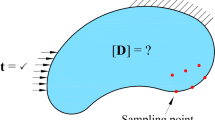Abstract
The Kelvin approach describing the structure of the generalized Hooke’s law is used to analyze the potential model of anisotropic creep of materials. The creep equations of incompressible transversely isotropic, orthotropic materials and those with cubic symmetry are considered. The eigen coefficients of anisotropy and eigen tensors for the anisotropy tensors of these materials are determined.
Similar content being viewed by others
References
Yu. N. Rabotnov, Creep Problems in Structural Members (Nauka, Moscow, 1966; North-Holland, Amsterdam, 1969).
O. V. Sosnin, “Anisotropy of Creep of Materials,” Prikl. Mekh. Tekh. Fiz. 6(6), 99–104 (1965) [J. Appl. Mech. Tech. Phys. 6 (6), 67–70 (1965)].
A. C. Pipkin, “Constraints in Linearly Elastic Materials,” J. Elast. 6(2), 179–193 (1976).
P. Podio-Guidugli and M. Vianello, “Internal Constraints and Linear Constitutive Relations for Transversely Isotropic Materials,” Rend. Lincei. Mat. Appl. Ser. 2(3), 241–248 (1991).
C. A. Felippa and E. Oñate, “Stress, Strain, and Energy Splittings for Anisotropic Elastic Solids under Volumetric Constraints,” Comput. Struct. 81(13), 1343–1357 (2003).
C. A. Felippa and E. Oñate, “Volumetric Constraint Models for Anisotropic Elastic Solids,” Trans. ASME, J. Appl. Mech. 71(5), 731–734 (2004).
K. Kowalczyk-Gajewska and J. Ostrowska-Maciejewska, “The Influence of Internal Restrictions on the Elastic Properties of Anisotropic Materials,” Arch. Mech. 56(3), 205–232 (2004).
Yu. N. Rabotnov, Mechanics of Deformable Solids (Nauka, Moscow, 1979) [in Russian].
B. D. Annin and N. I. Ostrosablin, “Anisotropy of Elastic Properties of Materials,” Prikl. Mekh. Tekh. Fiz. 49(6), 131–151 (2008) [J. Appl. Mech. Tech. Phys. 49 (6), 998–1014 (2008)].
F. R. Gantmacher, Theory of Matrices (Gostekhteoretizdat, Moscow, 1954; Academic Press, New York, 1985).
B. E. Pobedrya, Lectures on Tensor Analysis (Izd. Mosk. Univ., Moscow, 1979) [in Russian].
N. I. Ostrosablin, “Elasticity and State Eigenmodules for Materials of Crystallographic Symmetries,” in Dynamics of Continuous Media, No. 75 (Inst. of Hydrodynamics, Sib. Branch, USSR Acad. of Sci., Novosibirsk, 1986), pp. 113–125.
Author information
Authors and Affiliations
Corresponding author
Additional information
Original Russian Text © B.D. Annin, N.I. Ostrosablin.
__________
Translated from Prikladnaya Mekhanika i Tekhnicheskaya Fizika, Vol. 55, No. 1, pp. 5–12, January–February, 2014.
Rights and permissions
About this article
Cite this article
Annin, B.D., Ostrosablin, N.I. Anisotropy tensor of the potential model of steady creep. J Appl Mech Tech Phy 55, 1–7 (2014). https://doi.org/10.1134/S0021894414010015
Received:
Published:
Issue Date:
DOI: https://doi.org/10.1134/S0021894414010015




